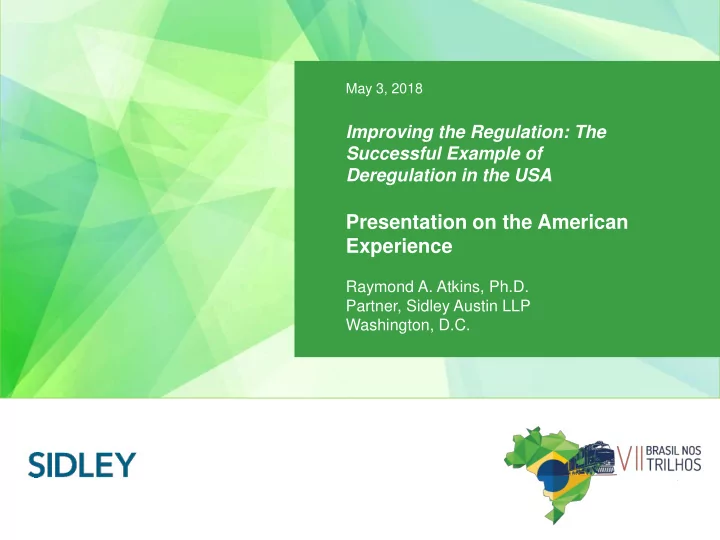

May 3, 2018 Improving the Regulation: The Successful Example of Deregulation in the USA Presentation on the American Experience Raymond A. Atkins, Ph.D. Partner, Sidley Austin LLP Washington, D.C.
Agenda I. The United States Rail Industry II. A Freight Rail Renaissance III. Five Key Lessons SIDLEY AUSTIN LLP 2
The United States Rail Industry 3
The Freight Rail Industry BNSF CN CP CSX KCS NS UP Short Line/Regional Multiple Owners Source: The Association of American Railroads SIDLEY AUSTIN LLP 4
Flourishing Short Line Railroads The Short Line and Regional Railroad Industry Nearly 49 Invest 10,000 24% of states customers revenue in capital & maintenance 47,500 Nearly 18,000 miles of track employees 29% $4.64 of total track in billion in 603 U.S. revenue short lines 1 in 5 cars are moved by short lines 5 Source: American Short Line and Regional Railroad Association
U.S. Department of Surface Transportation Transportation Board (safety regulation) (economic regulation) Federal Regulators 6
Key Facts • Seven major railroads • Six hundred smaller railroads • Invested over $660 billion on networks between 1980 and 2017 • Hauls 35% of all U.S. exports • Regulated at the federal level • Privately owned network
The Passenger Rail System: Four Passenger Services Intercity Mass Transit Light Rail Tourist 8
Intercity Passenger Rail SIDLEY AUSTIN LLP 9
Key Facts • Amtrak operates over the private freight rail networks, except between Boston and Washington • Massive public subsidies • Constant disputes between freight railroads and Amtrak • Growing interest in dedicated, private high-speed projects between major U.S. cities – Dallas to Houston – Orlando to Miami – Los Angeles to Las Vegas SIDLEY AUSTIN LLP 10
Why Look to the United States? • In 1970s, the freight rail system was on the verge of financial ruin. • In desperation, the U.S. government relaxed its hold on the industry. • The results transformed the industry into one of the most efficient modes of transportation in the world. 11
A Freight Rail Renaissance 12
A Freight Rail Renaissance SIDLEY AUSTIN LLP 13
Five Key Lessons 14
Lesson 1: Rationalization of the Network Drove Productivity, Safety and Resiliency • Line sales created a robust network of more than 600 efficient short line railroads to serve the last mile • A wave of major mergers increased economies of density and provided efficient single-line services • Abandonments shed unprofitable lines • Technology increased productivity SIDLEY AUSTIN LLP 15
Lesson 2: The Railroads Were Granted Pricing Flexibility to Charge Different Rates to Different Customers • Private contracts were lawful and encouraged • Differential pricing was permitted • Keeping competitive traffic on the network with lower prices benefited all shippers, including those with fewer transportation alternatives • Federal regulation of rates only where market failure occurred • Hard lesson for shippers and regulators to accept
Lesson 3: The United States Found Innovative Ways to Handle Unprofitable Light-Density Lines • Transferred failing lines to smaller short line railroads, with interchange agreements with the larger railroads • Permitted state and local authorities to buy failing lines without becoming a regulated common carrier • Created “Rail -to- Trails” program to protect valuable rail corridors for future use • Encouraged “Offers of Financial Assistance” to keep low-profit lines in the network • Tax incentives to spur short line investments 17
Lesson 4: Federal Regulators Set Uniform Rules to Avoid a Patchwork of State and Local Regulations • Economic regulation exclusively at the federal level • Only federal approval is needed to build a new railroad • Federal laws protect railroads from discriminatory taxes • Safety regulations permitted at the local level, until the federal government occupies the field
Freight and To compete with air passenger travel, intercity operations do not passenger mix well in the operations require United States, government particularly over subsidies, except the core network. between major metropolitan regions. Lesson 5: Public Passenger Operations Should Be on Dedicated Networks 19
Sidley We assist clients in key countries including: • • Austin LLP Argentina Dominican Republic • • Brazil Mexico • • Chile Paraguay Latin America • • Colombia Peru • • Practice Costa Rica Uruguay Sidley has maintained a valued presence in Latin America for more than five decades. Our lawyers have advised clients on some of their most high-profile matters and transactions throughout the region. In the course of this work, we have developed strong working relationships with local counsel in all major jurisdictions. Our global team, which features lawyers who are fluent in Portuguese and Spanish, possesses an in-depth understanding of local requirements and a perspective that spans borders.
Recommend
More recommend